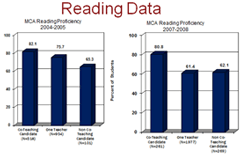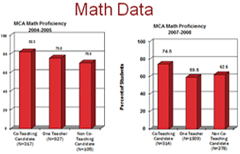Research results
Workshop 1 | Foundations

Why co-teach?
St. Cloud State University (SCSU) trained approximately 900 classroom teacher to mentor student teachers using co-teaching as part of the five year initiative in over 40 school districts. During that time, SCSU utilized the Teacher Quality Enhancement grant to work with a large school district partner and to study student achievement and engagement in learning in both co-taught and not co-taught classrooms over a five year period. Using quantitative measures (MAPS and MCA data) and qualitative data (surveys, focus groups, observations), SCSU was able to draw comparisons and conclusions for math and reading achievement in three different types of classrooms:
- with a school district teacher - teacher candidate,
- with a traditional student-teaching model (a student teacher was working in the room but not using the co-teaching model), and
- with the cooperating teacher and teacher candidate co-teaching.
Researchers found that for both math and reading, children learning in classrooms where a teacher candidate was placed using the co-teaching model made significantly HIGHER gains than both classrooms without a teacher candidate and classrooms with a traditional student-teacher.
Click on the image to see a bigger version.
See Data Information Sheet (opens new window) and Facts Sheet documents (opens new window).
Overall, researchers found that co-teaching helps to:
- reduce student-teacher ratio and enhance classroom management;
- create more instructional options for all students and increase student participation and engagement;
- Improve the academic performance of students.
- Higher gains were present in co-teaching classrooms for free/reduced price lunch eligible children, special education eligible children, and general population (overall)
- Less of an impact was present for ELLs (perhaps due to practices in co-teaching already present in ELL instruction or in the types of assessments used to track progress in ELL).
What do K-12 students say about co-teaching classrooms?
The researchers in the original grant also interviewed, surveyed, and held focus groups with K-12 students to gather data about their experiences in co-taught classrooms. Here’s what they had to say:
- More engaged in smaller groups
- Received more individual attention
- Get questions answered faster
- Get papers, assignments, and grades back faster
- Students behave better
- Fewer classroom disruptions
What are cooperating teachers saying about co-teaching?
Survey data and focus group data collected from cooperating teachers reported a high satisfaction with co-teaching, as follows:
- Ability to reach more students, particularly those with high needs (93.5%)
- Better relationship with their teacher candidate (91%)
- Experienced professional growth (89.2%)
- Enhanced energy for teaching (87.8%)
- Hosting a candidate without giving up my classroom (87.1%)
- Teacher candidate had a better experience than they would have through with a traditional model (81.7%)
What do teacher candidates say about co-teaching?
Co-teaching helped significantly improve:
- Classroom management skills (92.4%)
- Collaboration with other adults (92%)
- More teaching time (90%)
- Deeper understanding of the curriculum (89.2%)
- More opportunities for self-reflection (88.8% )
Previous: What is Co-Teaching?
© 2012, St. Cloud State University. Used with permission by the University of Minnesota-Twin Cities’ Office of Teacher Education (OTE) for the CEHD Partner Network

